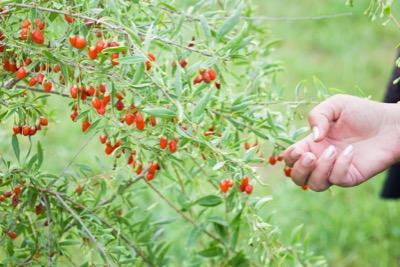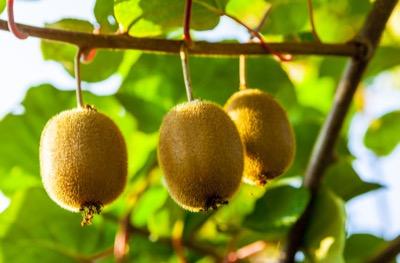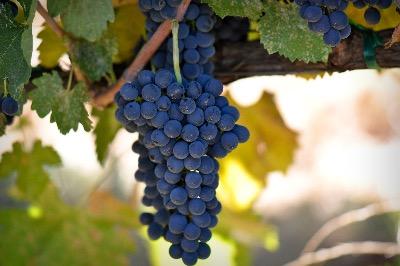Plant instructins fruit shrubs
Goji berry
First put the roots in a bucket of lukewarm water before planting into the ground. The goji berry grows well in any sandy soil that is well-permeable. The goji berry prefers full sun. Plant the shrub in a dry, nutrient-poor spot at the edge of the garden or as a tall impenetrable hedge. The planting distance between the shrubs should be about 1 to 1.5 metres. The shrubs are deciduous and very thorny. The goji berry is very hardy and therefore is easy to keep in our climate.
The flowers (from May to October) and berries are a feast for the eyes. Goji berries ripen in late summer/early autumn. Wear gloves and cut off the branches with the ripe berries intact. They can be eaten fresh and are excellent for drying or making into a delicious jam or juice.
Redcurrent Shrub
'Ribes Rubrum Jonkheer van Tets' is a red currant. The shrub grows vigorously and has a high fruit yield. It is one of the earliest ripening red currants. By the end of June, the berries are already ripe. The berries grow in long bunches and have a tart, but refreshing taste. You can eat them, for example, in puddings or as jam. The shrub blooms in spring with small green-white flowers.
Pruning influences the quantity and size of the berries and is therefore very important. The best time to prune the shrub is in early spring. In order to keep the bush compact, you can prune the dead branches up to a healthy lateral branch. As it is a self-pollinating shrub, it attracts butterflies and bees. You can plant it in the garden, but also on a balcony or terrace. It grows well in any soil and likes full sun.
Gooseberry
'Ribes uva-crispa Captivator' is a red gooseberry. The advantage of this shrub is that it has fewer thorns on its branches compared to other gooseberry species. This makes it easier to pick the fruit. The red gooseberry blossoms in April with green-white flowers and around July the fruits are ripe for picking. The fruits are medium-sized, round and light red. It is not a common shrub to grow at home, but it is a very easy plant for the novice fruit gardener or for children who like to garden.
The gooseberry is great for making jam or wine. In the winter, this bush loses its leaves making it the best time for pruning. Without leaves, the bush is easier to see so you can prune it back into the desired shape. This red gooseberry prefers a place in the sun in soil that is not too damp.
 Blackberry
Blackberry
The plants can handle shade, but give more fruit in a sunny and sheltered spot. Thick branches should be tied down in the spring, as they give the best fruit. Prune everything that is unnessary. Use a wall or fence to guide the branches with wires. The wires can also be stretched between two poles.
Blackberries bear fruit on stems that were formed the previous year. Prune regularly, both in spring and autumn. After harvesting, completely prune the branches that bore fruit. Regular pruning also prevents the spread of diseases. Rubus fruticosus Loch Ness' tolerates light frost, but we recommend protecting this blackberry when it freezes more than 10°C. This can damage or even lead to the death of the bush.
Blueberry
Plant in any fertile, well-drained soil, but for the highest yields in acidic soil. In a pot, you can also enjoy it on your terrace. From May/June onwards you can pick the first berries. From organic cultivation.
Kiwi
The plant likes a slightly moist yet well-drained soil in full sun. You can also enjoy it in a pot on your terrace. Organic cultivation
It's an easy and self-pollinating kiwi. It is a fast-growing vine and is best placed against a climbing frame, fence or pergola. The kiwi blooms in the months of May and June with white-pink flowers. The first ripe fruits will appear in early September. Bear in mind that it can take several years before the plant starts to produce fruit. In general, this takes three to five years. The fruits have a hairy skin, are oval in shape and have bright green flesh, with a white core and a ring of black seeds around this core.
The kiwi plant survives well in our climate and is hardy to -12° C. If the plant is not yet mature, it is best to cover it in winter, when there is severe frost. The kiwi plant needs a warm and sunny spot. The more sun the sweeter the fruit. A south-facing garden, out of the wind, is perfect. Pruning is best done in December or January. Prune back the new branches. The branches which grew last will bear fruit the following year. When you do not want the plant to grow too big, it is best to only leave 40 centimeters of the newly formed branch.
Raspberry
In June, the first harvest is on the old branches of the bush; in autumn, the second harvest is on the new branches. The raspberry is easy to maintain and can survive in all climates. You do not need to prune the bush the first year. After that you can prune back the branches in early spring. The plant has a steady growth and a good resistance against diseases. Birds also love raspberries, so protect the bush by covering it with a net, for example
Black Currant Shrub
The shrub needs direct sunlight for optimal yield and sweeter berries. The berries of this shrub can be picked from June onwards. The fruit can be eaten fresh, but making it into jam or juice is even tastier. The fruit is best known for the Cassis drink. With its high vitamin C content, it is one of the healthiest berries. The shrub can be pruned between February and March, remove only the dead branches. The less you prune, the more chance there is of berries. It is easy to maintain and bears fruit after just one year. The shrub loses its leaves in winter, but can withstand temperatures up to -34 degrees Celsius without a problem.
White grape vine
It is a climber that can grow several meters high. You can guide it into all kinds of shapes and keep it very compact by pruning it well. You can easily guide the grape along a pergola or on a wall with tension wires. The grape first produces insignificant clusters of flowers in July-August, after which white bunches of grapes form. The fruits are white-green in colour, juicy with a sweet taste. You can eat them fresh or use them to make jam, juice or wine.
The grape bush needs plenty of sun in order to ripen and loves heat, so a south-facing location is ideal. The grapes can be harvested from mid-September onwards. The soil should be well-drained, nutritious and preferably not too acidic but rather calcareous. Pruning increases the fruit yield and the plant looks neater too. It is best to prune the plant between November and February, but not during severe frost. Prune redundant side and main branches. This grape variety is hardy and can withstand temperatures up to -20 degrees without problems.
Blue grape vine
It is a climber that can grow several meters high. You can guide it into all sorts of shapes and keep it very compact by pruning it well. You can easily guide the grape along a pergola or along a wall with tension wire. The grape first produces insignificant clusters of flowers in July-August, after which the blue grape bunches form. The fruits are blue in colour and juicy with a sweet taste. You can eat them fresh or use them to make jam, jelly or wine. The grape plant needs a lot of sun to ripen and loves heat so a south-facing location is ideal.
The grapes can be harvested from mid-September onwards. The soil should be well-drained, nutritious, preferably not too acidic but rather calcareous. Pruning increases the fruit yield and the plant looks neater too. It is best to prune the plant in the period between November and February, but not during severe frost. Prune redundant side and main branches. This grape variety is hardy and can tolerate temperatures up to -23 degrees without problems.








